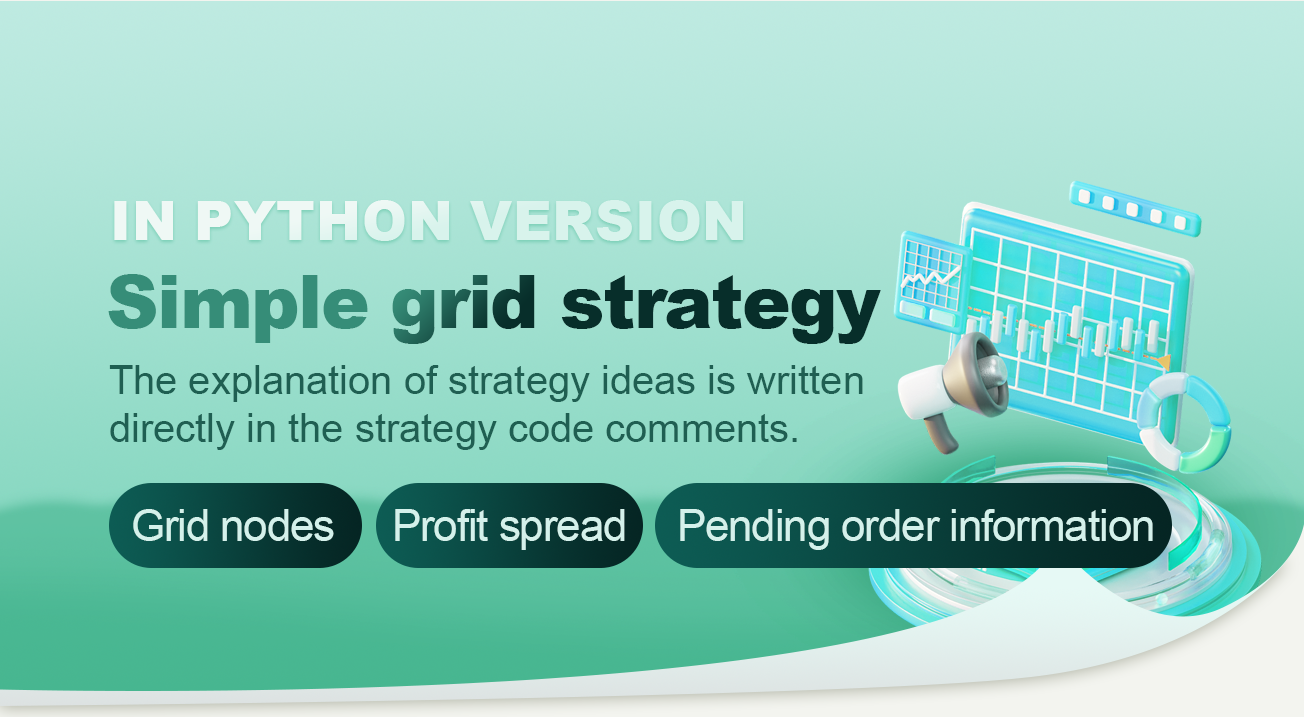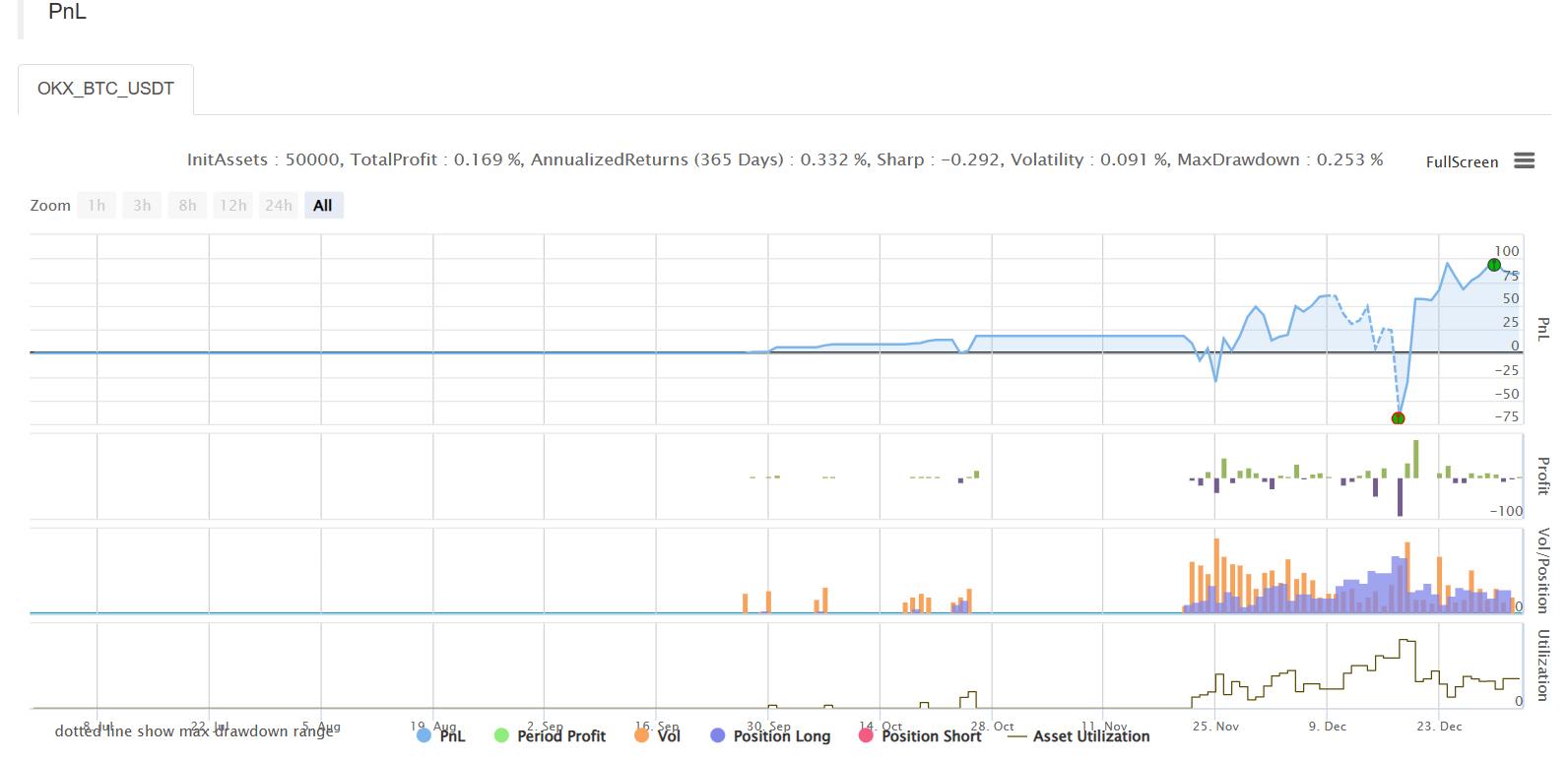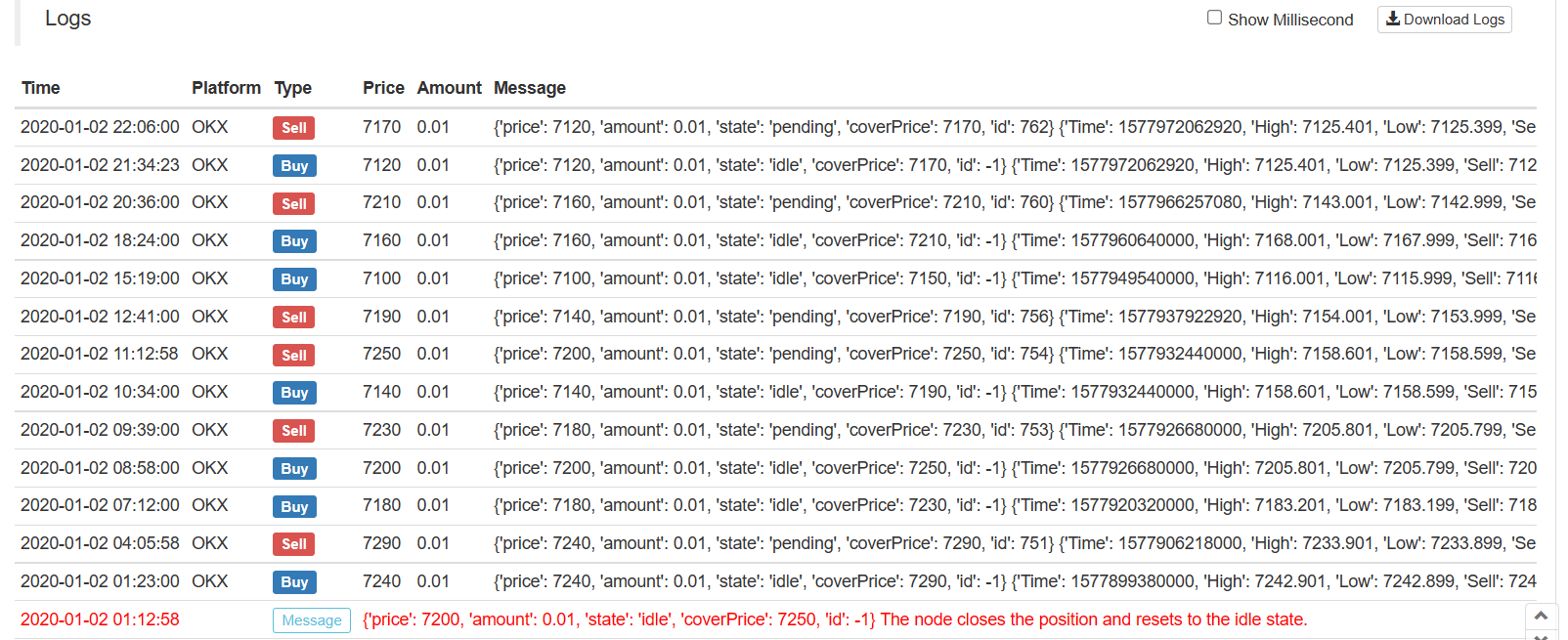Chiến lược lưới đơn giản trong phiên bản Python
Tác giả:FMZ~Lydia, Tạo: 2022-12-23 21:00:45, Cập nhật: 2025-01-11 18:19:24
Chiến lược lưới đơn giản trong phiên bản Python
Không có nhiều chiến lược Python trên hình vuông chiến lược. Một phiên bản Python của chiến lược lưới được viết ở đây. Nguyên tắc của chiến lược rất đơn giản. Một loạt các nút lưới được tạo ra bởi một khoảng cách giá cố định trong phạm vi giá. Khi thị trường thay đổi và giá đạt đến vị trí giá nút lưới, lệnh mua được đặt. Khi lệnh được đóng, tức là, theo giá của lệnh đang chờ cộng với chênh lệch lợi nhuận, chờ lệnh bán để đóng vị trí.
Không cần phải nói rằng rủi ro của chiến lược lưới là bất kỳ chiến lược kiểu lưới nào cũng là đặt cược rằng giá dao động trong một phạm vi nhất định. Một khi giá vượt ra khỏi phạm vi lưới, nó có thể gây ra tổn thất nổi nghiêm trọng. Do đó, mục đích của việc viết chiến lược này là để cung cấp tham chiếu cho ý tưởng viết chiến lược Python hoặc thiết kế chương trình. Chiến lược này chỉ được sử dụng để học và có thể có rủi ro trong bot thực.
Lời giải thích về ý tưởng chiến lược được viết trực tiếp trong các bình luận về mã chiến lược.
Mã chiến lược
'''backtest
start: 2019-07-01 00:00:00
end: 2020-01-03 00:00:00
period: 1m
exchanges: [{"eid":"OKEX","currency":"BTC_USDT"}]
'''
import json
# Parameters
beginPrice = 5000 # Grid interval begin price
endPrice = 8000 # Grid interval end price
distance = 20 # Price distance of each grid node
pointProfit = 50 # Profit spread per grid node
amount = 0.01 # Number of pending orders per grid node
minBalance = 300 # Minimum fund balance of the account (at the time of purchase)
# Global variables
arrNet = []
arrMsg = []
acc = None
def findOrder (orderId, NumOfTimes, ordersList = []) :
for j in range(NumOfTimes) :
orders = None
if len(ordersList) == 0:
orders = _C(exchange.GetOrders)
else :
orders = ordersList
for i in range(len(orders)):
if orderId == orders[i]["Id"]:
return True
Sleep(1000)
return False
def cancelOrder (price, orderType) :
orders = _C(exchange.GetOrders)
for i in range(len(orders)) :
if price == orders[i]["Price"] and orderType == orders[i]["Type"]:
exchange.CancelOrder(orders[i]["Id"])
Sleep(500)
def checkOpenOrders (orders, ticker) :
global arrNet, arrMsg
for i in range(len(arrNet)) :
if not findOrder(arrNet[i]["id"], 1, orders) and arrNet[i]["state"] == "pending" :
orderId = exchange.Sell(arrNet[i]["coverPrice"], arrNet[i]["amount"], arrNet[i], ticker)
if orderId :
arrNet[i]["state"] = "cover"
arrNet[i]["id"] = orderId
else :
# Cancel
cancelOrder(arrNet[i]["coverPrice"], ORDER_TYPE_SELL)
arrMsg.append("Pending order failed!" + json.dumps(arrNet[i]) + ", time:" + _D())
def checkCoverOrders (orders, ticker) :
global arrNet, arrMsg
for i in range(len(arrNet)) :
if not findOrder(arrNet[i]["id"], 1, orders) and arrNet[i]["state"] == "cover" :
arrNet[i]["id"] = -1
arrNet[i]["state"] = "idle"
Log(arrNet[i], "The node closes the position and resets to the idle state.", "#FF0000")
def onTick () :
global arrNet, arrMsg, acc
ticker = _C(exchange.GetTicker) # Get the latest current ticker every time
for i in range(len(arrNet)): # Iterate through all grid nodes, find out the position where you need to pend a buy order according to the current market, and pend a buy order.
if i != len(arrNet) - 1 and arrNet[i]["state"] == "idle" and ticker.Sell > arrNet[i]["price"] and ticker.Sell < arrNet[i + 1]["price"]:
acc = _C(exchange.GetAccount)
if acc.Balance < minBalance : # If there is not enough money left, you can only jump out and do nothing.
arrMsg.append("Insufficient funds" + json.dumps(acc) + "!" + ", time:" + _D())
break
orderId = exchange.Buy(arrNet[i]["price"], arrNet[i]["amount"], arrNet[i], ticker) # Pending buy orders
if orderId :
arrNet[i]["state"] = "pending" # Update the grid node status and other information if the buy order is successfully pending
arrNet[i]["id"] = orderId
else :
# Cancel h/the order
cancelOrder(arrNet[i]["price"], ORDER_TYPE_BUY) # Cancel orders by using the cancel function
arrMsg.append("Pending order failed!" + json.dumps(arrNet[i]) + ", time:" + _D())
Sleep(1000)
orders = _C(exchange.GetOrders)
checkOpenOrders(orders, ticker) # Check the status of all buy orders and process them according to the changes.
Sleep(1000)
orders = _C(exchange.GetOrders)
checkCoverOrders(orders, ticker) # Check the status of all sell orders and process them according to the changes.
# The following information about the construction status bar can be found in the FMZ API documentation.
tbl = {
"type" : "table",
"title" : "grid status",
"cols" : ["node index", "details"],
"rows" : [],
}
for i in range(len(arrNet)) :
tbl["rows"].append([i, json.dumps(arrNet[i])])
errTbl = {
"type" : "table",
"title" : "record",
"cols" : ["node index", "details"],
"rows" : [],
}
orderTbl = {
"type" : "table",
"title" : "orders",
"cols" : ["node index", "details"],
"rows" : [],
}
while len(arrMsg) > 20 :
arrMsg.pop(0)
for i in range(len(arrMsg)) :
errTbl["rows"].append([i, json.dumps(arrMsg[i])])
for i in range(len(orders)) :
orderTbl["rows"].append([i, json.dumps(orders[i])])
LogStatus(_D(), "\n", acc, "\n", "arrMsg length:", len(arrMsg), "\n", "`" + json.dumps([tbl, errTbl, orderTbl]) + "`")
def main (): # Strategy execution starts here
global arrNet
for i in range(int((endPrice - beginPrice) / distance)): # The for loop constructs a data structure for the grid based on the parameters, a list that stores each grid node, with the following information for each grid node:
arrNet.append({
"price" : beginPrice + i * distance, # Price of the node
"amount" : amount, # Number of orders
"state" : "idle", # pending / cover / idle # Node Status
"coverPrice" : beginPrice + i * distance + pointProfit, # Node closing price
"id" : -1, # ID of the current order related to the node
})
while True: # After the grid data structure is constructed, enter the main strategy loop
onTick() # Processing functions on the main loop, the main processing logic
Sleep(500) # Control polling frequency
Ý tưởng thiết kế chính của chiến lược là so sánh danh sách hiện tại của các đơn đặt hàng đang chờ được trả về bởiGetOrdersgiao diện theo cấu trúc dữ liệu lưới được duy trì bởi chính bạn. Phân tích các thay đổi của các lệnh đang chờ (cho dù chúng được đóng hay không), cập nhật cấu trúc dữ liệu lưới, và thực hiện các hoạt động tiếp theo. Ngoài ra, các lệnh đang chờ sẽ không bị hủy cho đến khi giao dịch hoàn thành, ngay cả khi giá lệch, bởi vì thị trường tiền kỹ thuật số thường có tình huống của các chân, các lệnh đang chờ này cũng có thể nhận được các lệnh của chân (nếu số lượng các lệnh đang chờ được giới hạn trong sàn giao dịch, nó sẽ được điều chỉnh).
Khám phá dữ liệu chiến lược sử dụngLogStatuschức năng để hiển thị dữ liệu trên thanh trạng thái trong thời gian thực.
tbl = {
"type" : "table",
"title" : "grid status",
"cols" : ["node index", "details"],
"rows" : [],
}
for i in range(len(arrNet)) :
tbl["rows"].append([i, json.dumps(arrNet[i])])
errTbl = {
"type" : "table",
"title" : "record",
"cols" : ["node index", "details"],
"rows" : [],
}
orderTbl = {
"type" : "table",
"title" : "orders",
"cols" : ["node index", "details"],
"rows" : [],
}
Ba bảng được xây dựng. Bảng đầu tiên hiển thị thông tin của mỗi nút trong cấu trúc dữ liệu lưới hiện tại, bảng thứ hai hiển thị thông tin bất thường và bảng thứ ba hiển thị thông tin liệt kê thực tế của sàn giao dịch.
Kiểm tra hậu quả



Địa chỉ chiến lược
Chiến lược là cho mục đích học tập và backtesting chỉ, và nó có thể được tối ưu hóa và nâng cấp nếu bạn quan tâm.
- Thực hành định lượng của DEX Exchange (2) -- Hướng dẫn người dùng Hyperliquid
- DEX giao dịch định lượng thực hành ((2) -- Hyperliquid sử dụng hướng dẫn
- Thực hành định lượng của DEX Exchange (1) -- dYdX v4 User Guide
- Giới thiệu về trọng tài lead-lag trong tiền điện tử (3)
- DEX giao dịch định lượng thực hành ((1) -- dYdX v4 hướng dẫn sử dụng
- Giới thiệu về bộ phận Lead-Lag trong tiền kỹ thuật số (3)
- Giới thiệu về Trọng tài Lead-Lag trong Cryptocurrency (2)
- Giới thiệu về bộ phận Lead-Lag trong tiền kỹ thuật số (2)
- Thảo luận về tiếp nhận tín hiệu bên ngoài của nền tảng FMZ: Một giải pháp hoàn chỉnh để tiếp nhận tín hiệu với dịch vụ Http tích hợp trong chiến lược
- Phân tích nhận tín hiệu bên ngoài nền tảng FMZ: Chiến lược xây dựng dịch vụ HTTP để nhận tín hiệu
- Giới thiệu về Trọng tài Lead-Lag trong Cryptocurrency (1)
- Các công cụ tốt hơn làm cho công việc tốt hơn - học cách sử dụng môi trường nghiên cứu để phân tích các nguyên tắc giao dịch
- Các chiến lược phòng ngừa rủi ro giữa các loại tiền tệ trong giao dịch định lượng các tài sản blockchain
- Mua hướng dẫn chiến lược tiền kỹ thuật số của FMex trên FMZ Quant
- Dạy bạn viết các chiến lược -- cấy ghép một chiến lược MyLanguage (Tiến bộ)
- Dạy bạn viết chiến lược -- cấy ghép một chiến lược MyLanguage
- Dạy bạn thêm hỗ trợ đa biểu đồ cho chiến lược
- Dạy bạn viết một hàm tổng hợp K-line trong phiên bản Python
- Phân tích chiến lược kênh Donchian trong môi trường nghiên cứu
- Khi FMZ gặp ChatGPT, ghi nhớ một lần thử sử dụng AI để hỗ trợ học hỏi giao dịch định lượng
- Công cụ giao dịch định lượng sẵn dùng cho các tùy chọn tiền kỹ thuật số
- Chiến lược dòng lệnh chờ tuyến tính được phát triển dựa trên chức năng phát lại dữ liệu
- Chiến lược để mua người chiến thắng của phiên bản Python
- FMZ Journey -- với Chiến lược chuyển đổi
- Dạy bạn chuyển đổi một chiến lược Python một loài thành một chiến lược đa loài
- Thực hiện một robot giao dịch định lượng bắt đầu hoặc dừng thời gian thiết bị bằng cách sử dụng Python
- Oak dạy bạn sử dụng JS để giao diện với FMZ mở rộng API
- Gọi giao diện Dingding để nhận ra thông báo đẩy robot
- Chiến lược sắp xếp chờ cân bằng (Chiến lược giảng dạy)
- Những suy nghĩ về chuyển động tài sản thông qua chiến lược phòng ngừa rủi ro hợp đồng
- Nhiều năm sau, bạn sẽ thấy bài viết này là bài viết có giá trị nhất trong sự nghiệp đầu tư của bạn - tìm hiểu nơi lợi nhuận và rủi ro đến từ đâu